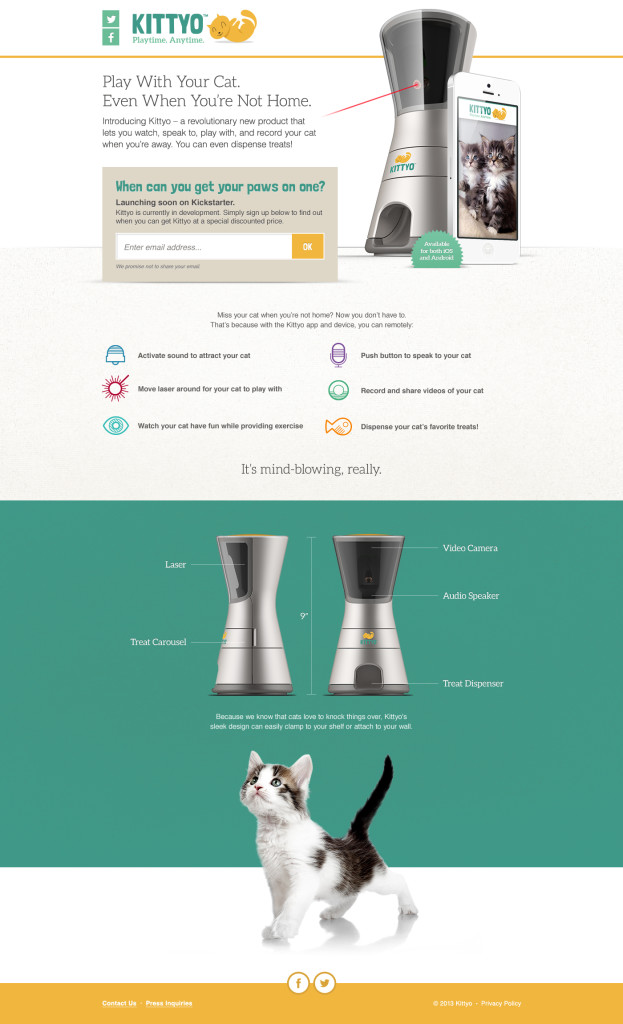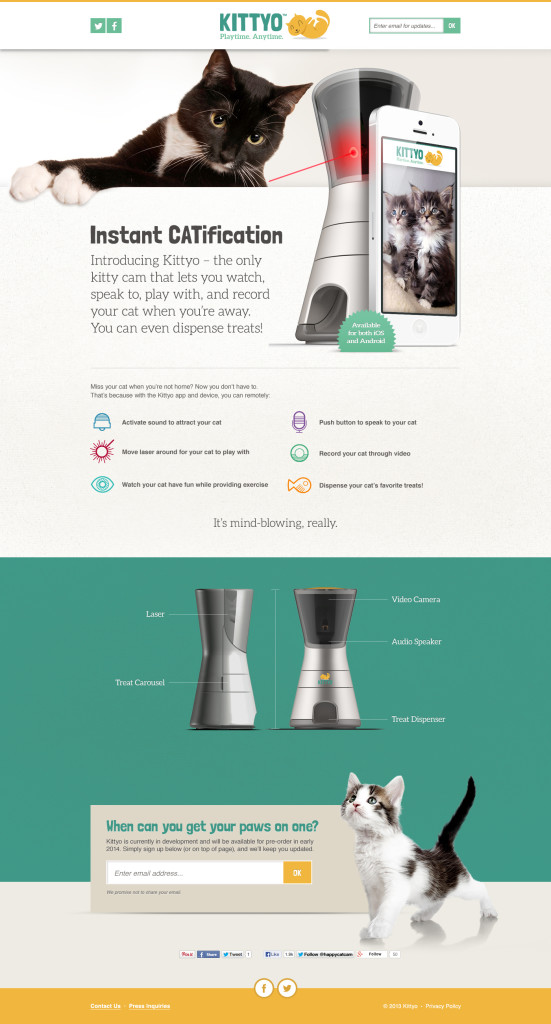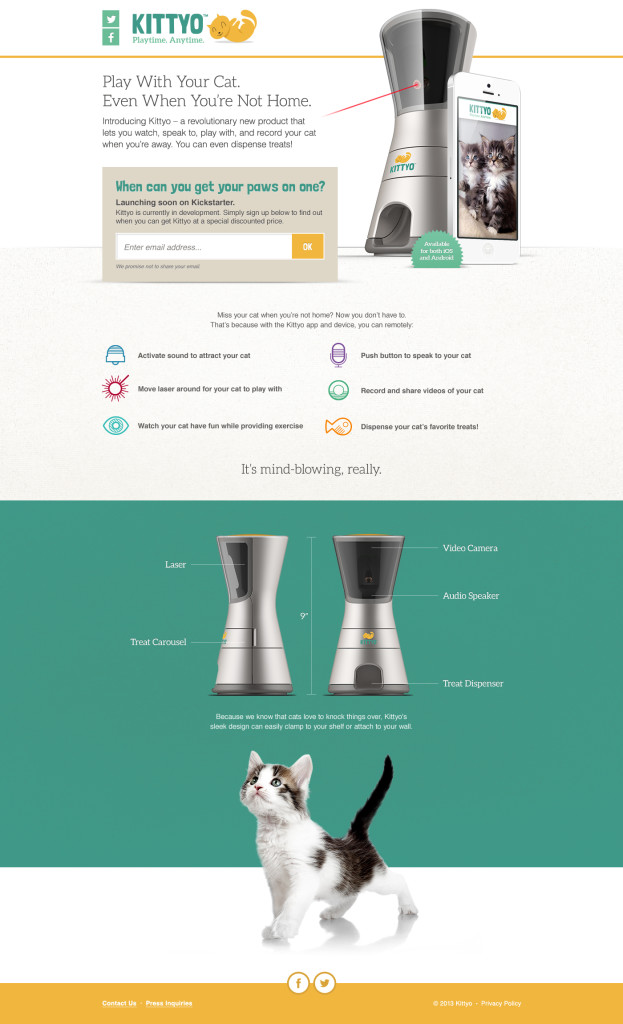Last week, I explained how Kittyo’s success was perfectly planned and that the project was funded even before it launched.
It worked.
Kittyo’s $30,000 Kickstarter goal was fully funded (100%) in only 45 minutes. They were 200% funded in just a few hours and just passed $200,000 with 19 days to go.
Today, we’re going to analyze exactly how Kittyo used what I call, “The MacGyver Trick” to raise $200,000 in two weeks and crush their Kickstarter goal.
Remember MacGyver?
Growing up, I used to watch Monday Night Football on TV every week. But one hour before the real-life gladiators locked horns in a physical battle, I would watch a fictional character triumph in an intellectual one.
Every episode, the show’s main character MacGyver, played brilliantly by Richard Dean Anderson, found himself in a dire situation, often created by a recurring villain or that episode’s antagonist-of-the-week.
And every time, MacGyver solved complex problems and got himself out of these tough jams using everyday objects, like his trusty Swiss Army Knife, duct tape and whatever else he could find at his disposal.
So what does this have to do with crowdfunding?
In the show, MacGyver’s backstory was being a Bomb Team Technician in Vietnam.
In many episodes, the bad guys had set a bomb or explosive device that MacGyver had to disarm, often with only a few suspenseful seconds on the clock.
Tick, tock…
What if, instead of only a few seconds to defuse the bomb, MacGyver had hours?
Or days? Or even months?
For one, it would have killed the suspense and ruined the show, but on the other hand, MacGyver would have had more time to do it right.
Most creators launch their crowdfunding campaign and only THEN start marketing and promotion, putting themselves in a stressful MacGyver-like situation.
The difference between you and MacGyver? Instead of 10 seconds until the bomb goes off, you have 30 days until your campaign ends.
Tick, tock…
MacGyver only had a few seconds to cut the red wire or blue wire.
But he didn’t have a choice. You do.
You can plan ahead and give yourself more time before you launch your crowdfunding campaign.
How Kittyo used “The MacGyver Trick” to raise $200,000 in two weeks
When Lee first came to me in September, 2013, we had coffee and discussed his upcoming launch of Kittyo.
He had a great idea. He a had great product design. He had a very clear market (cat owners.)
The one thing he needed was permission to talk to those cat owners.
There are lots of ways to build permission and trust. If you’ve been writing a well-read blog for years or have a robust email list, you already have permission. But most crowdfunding creators don’t have that.
Building permission is the single most impactful thing you can do before any crowdfunding project. And if you haven’t built that permission already, a well-designed landing page is the best way to do it.
So to start, you need to build a clear, well-designed landing page that gives people the opportunity to opt-in.
And you need to start early. Your landing page should be live at least a month or two before your campaign launches and ideally even longer.
The reason Lee and the Kittyo team were fully funded in 45 minutes (and are at $200,000 in only two weeks) is that they started building permission six months before they launched and they designed a great landing page to build permission.
Build a great landing page
Instead of cramming all the marketing and promotion into the 30 days of the campaign, we wanted to do the opposite. We wanted to build a base of people that we had permission to notify when the campaign launched.
Our process:
- Plan: Start early (ideally, months before launch) and design a marketing and press plan.
- Build: Build a great landing page that explains the product and allows you to collect emails from interested people.
- Launch: Launch the landing page to the world.
- Promote: Send traffic to the landing page by promoting it in various ways and in various channels (more on this in the next two posts). Test what works and what doesn’t and repeat what works well.
Lee agreed to push off the campaign launch date by a few months to give us more time to plan.
The key elements of a great landing page
So next, we had to build a great landing page. The key elements of a great landing page are fairly simple:
- The Headline: A great landing page must have a simple, clear headline that not only grabs viewers’ interest, but tells them exactly what to expect. You have about 3 seconds (maybe less) to compel them to keep reading. Clarity is critical.
- Supporting detail: It’s important to have some supporting detail below the headline, but not too much. You want the reader to finish reading and move on to…
- The Call-To-Action: A singular, call to action (email opt-in) as the primary design element on the page, above the fold.
- The Promise: A compelling promise or a reason to sign up (now, not later). Explain exactly what benefit the user gets by giving you their email.
- Design and Branding: Plain, text-heavy landing pages are boring. A great picture really is worth a thousand words. If you have a compelling video, even better. Colors, typography and consistently branded design elements are critical. Great design imbues trust and quality beyond the design itself.
Getting started is half done
You can’t optimize what isn’t built yet, so the first step is to build the landing page with the key components above.
It’s fine if it’s less than perfect. In fact, it should be. As French philosopher, writer and landing page designer Voltaire taught us, “the best is the enemy of the good”.
The important part is that it’s done.
Then you can start optimizing.
Kittyo Landing Page – Version 1:
The first version of the landing page Lee created was beautifully designed but had some issues, so the next step was to optimize the landing page.
Below is Lee’s first landing page, before optimization.
Let’s call this Version 1.
Note: These versions of Kittyo’s landing page were never previously published, but I promised to take you all “behind-the-scenes”, and Lee graciously agreed to let me show you everything to better demonstrate the process.
(You can click on any of the landing page images to view a larger version.)
Analysis of Version 1:
Now, let’s review it, using our simple 5-step landing page formula:
- The Headline: This “When you’re away…the cat will play.” headline is a clever riff on a well known phrase but it doesn’t explain the core benefit to the user in a compelling way, which is the main job of the headline.
- Supporting detail: In this version, there was still some lorem ipsum placeholder copy but there were a couple too many cat puns.
- The Call-To-Action: Initially, the opt-in box was too far down the page. Users had to scroll to the bottom of the page before they even had the chance to opt-in.
- The Promise: It’s not terrible but the “stay updated with our progress” doesn’t offer any additional benefit or incentive to signup.
- Design and Branding: This part was perfect. The Kittyo team has great design and branding, including crisp photography (both of the cats and of the product itself), great consistent colors and beautiful, clean typography. At this point, the Kittyo team didn’t have a shot of the product to add, but that would come in V2.
Kittyo Landing Page – Version 2:
After some recommendations, Lee’s team revised the landing page and version 2 was much better.
Analysis of Version 2:
Again, let’s review it, using our simple 5-step landing page formula:
- The Headline: The new main headline “Instant CATification” was still too much ‘cat pun’, but the sub-headline was improving and framing the specific user benefit much better.
- Supporting detail: In this version, the icons + bulleted features and benefits were clear and compelling.
- The Call-To-Action: Again, the main opt-in box is too far down at the bottom of the page. Another one was added in the header but neither were optimally placed, above the fold in the main part of the page as the primary call-to-action.
- The Promise: This promise is much better. It clearly explains that “Kittyo is currently in development and will be available for pre-order in early 2014. Simply sign up below (or on top of page), and we’ll keep you posted.” That’s a lot of good, specific information. The only thing missing is a more compelling reason for users to sign-up.
- Design and Branding: Again, the design and branding were stellar. This version included the new product shot with the laser and the photo of the cat.
Kittyo Landing Page – Version 3: “Ship it.”
In the final version Lee’s team executed in a big way and delivered one of the single best landing pages I’ve ever seen for any product or service.
Here is the final version (this version was live up until the Kickstarter launch on April 21st):
Analysis of Version 3:
Again, let’s review the final version, using our simple 5-step landing page formula:
- The Headline: The new main headline is perfect. “Play With Your Cat. Even When You’re Not Home.” is clear and compelling. It describes the exact benefit to the user in simple, straightforward, human language.
- Supporting detail: The sub-headline was much improved and the icons + bulleted features and benefits helped support the value proposition.
- The Call-To-Action: The call-to-action was perfectly placed in the middle of the page, below the headline + sub-headline and right next to the large product “hero” image.
- The Promise: This promise is perfect. It not only explains that Kittyo is currently in development and will be launching soon on Kickstarter, but it also adds a compelling reason for users to sign-up, “Sign up below to find out when you can get Kittyo at a special discounted price.” This wasn’t just a gimmick, the early backers that opted-in to the page did get Kittyo at the cheapest “super early bird” $99 price, a level which sold out all 1,000 units quickly.
- Design and Branding: The design is basically perfect. Clean colors, consistent branding and ideal typography wrap around a huge, clear hero image of the product and a perfectly placed opt-in box.
So did it work?
In a word, absolutely.
The quality was proven out when the landing page converted traffic to email opt-ins at between 40-50%, depending on traffic source. (That means 40-50% of the visitors to page entered their email to receive updates.)
40-50% is well above the industry average.
Kudos to Lee and the Kittyo team for executing on the strategy and building an A+ landing page.
Summary
Launching your crowdfunding campaign and then starting the marketing and promotion is putting yourself in a MacGyver-like crisis situation.
Instead, start months ahead of time and build the perfect landing page to communicate your project to the right groups. Collect emails to gain permission to let them know when you launch. Offer a compelling reason for them to opt-in, like an early bird discount.
Next week: How Kittyo drove loads of traffic to their landing page
In next week’s post, we’ll explain exactly how Lee and the Kittyo team sent a TON of qualified traffic (not just any traffic but highly targeted cat-lovers) to their landing page, which resulted in collected over 13,000 emails in the months leading up to their Kickstarter launch.
Fun MacGyver extras
Fun, random facts and links about MacGyver (from Wikipedia and YouTube):
- The character’s full name was “Angus MacGyver”, although his first name is rarely uttered in the show.
- Henry Winkler (aka, “The Fonz”) was an executive producer of MacGyver, having just finished his run on Happy Days and looking for a new project.
- On the show, Richard Dean Anderson would almost always do his own stunts, though in later seasons he reduced his participation because of accumulating injuries.
- In 2006, Richard Dean Anderson appeared in a Super Bowl commercial for MasterCard. You can watch the full commercial, including a making-of interview here on YouTube.
- Want to see a classic MacGyver clip where he disarms a bomb with a paper clip? Enjoy. (It’s the clip where the image above came from.)
Photo credit: CBS Entertainment




Pingback: The Famatic case: What to do before you launch your crowdfunding campaign » StartupJuncture()
Pingback: How Kittyo Gathered 13,000 Opt-In Emails in Only 5 Months – Part 1 (Includes Successful Templates, Strategies, etc.) | Crowdfunding Hacks()
Pingback: 3 misconceptions entrepreneurs still have about crowdfunding | Soviders Tech()
Pingback: 070: Rick Chen from Pozible & crowdfunding »()
Pingback: Guest Teacher: Avoid These 5 Crowdfunding Mistakes with Clay Hebert()